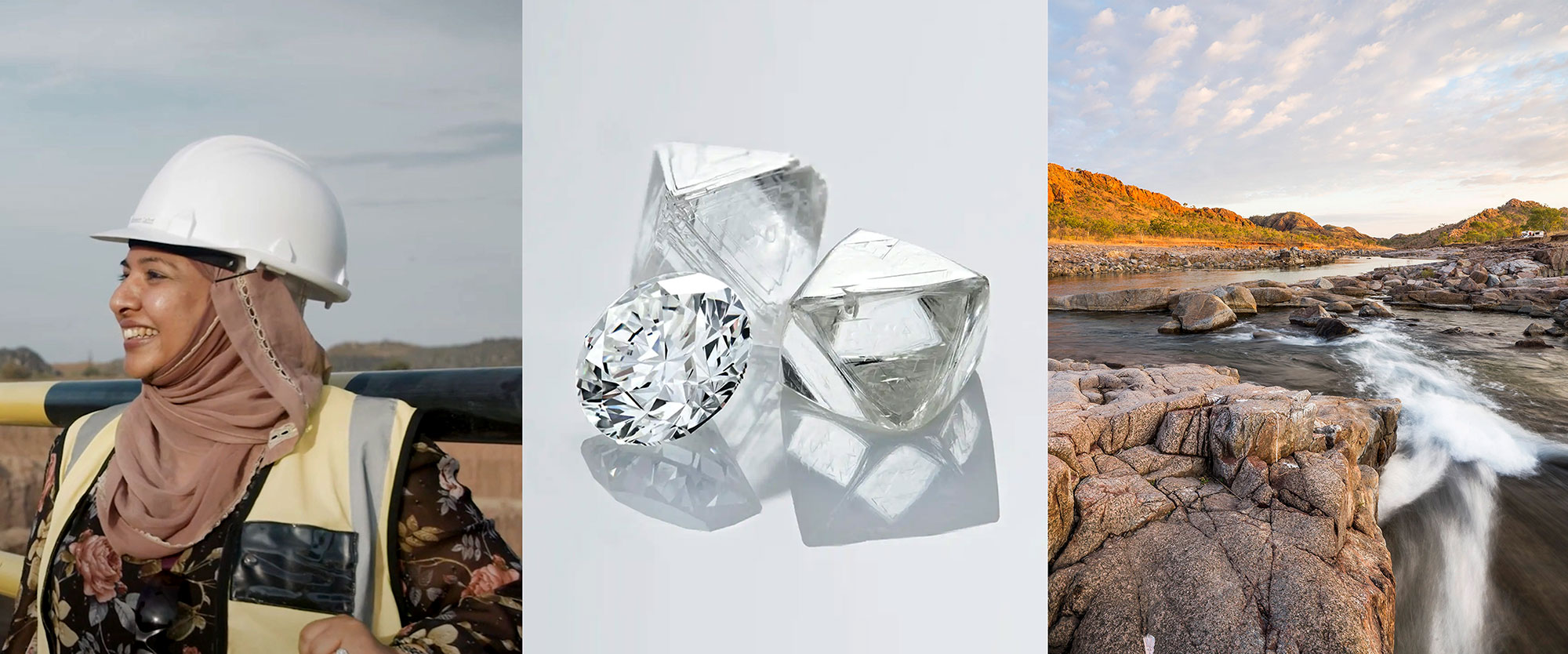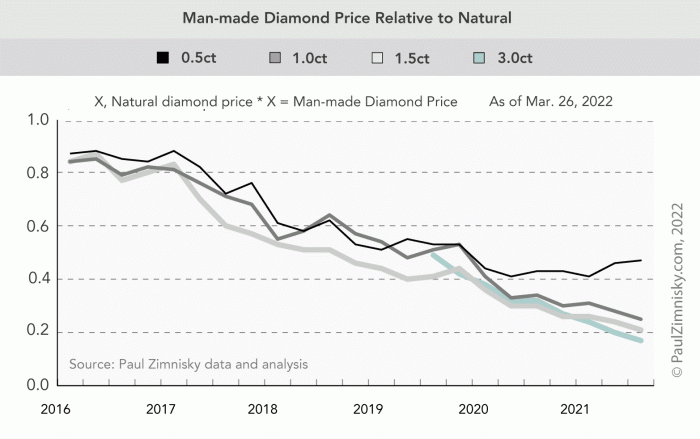Natural and Lab Grown Diamond FAQs
Answers to the most frequently asked questions about diamonds.

Shopping for diamonds can be an overwhelming experience. You are faced with conflicting information and a vast amount of knowledge to absorb about a complex product. Our comprehensive FAQ answers the most frequently asked questions about diamonds and provides straightforward, factual answers, so you can shop for diamonds with confidence.
What is a natural diamond?
A natural diamond is a finite mineral created by nature consisting of a crystalline form of pure carbon, the hardest naturally occurring substance. The word “diamond” alone always means a natural diamond.
What is a laboratory grown diamond?
A laboratory grown diamond, also called a synthetic diamond or lab created diamond, is a man-made product that mimics the physical characteristics and optical properties of a natural diamond but can be made in unlimited quantities.
Do lab grown diamonds hold value?
Over the last 35 years, natural diamonds have shown to appreciate in price by approximately 3% on average every year, and in its 2019 Global Diamond Industry Report, Bain & Co found that over the past 50 years, the diamond market has grown three times. Between 2016-2022, LGD prices have dropped significantly down from 80% of the natural price in 2016 to 20-25% in 2022. Similarly, synthetic rubies and sapphires established their price at 10% of their natural counterparts.
Are laboratory grown diamonds identical to natural diamonds?
How can you tell them apart?
How can you tell them apart?
No—laboratory grown diamonds are not identical to natural diamonds. Their origin is the primary difference. Laboratory grown diamonds are mass produced in factories, located primarily in China, India and Singapore in industrial reactors. The rapid, artificial production process which occurs in just 2 weeks creates telltale marks within the stones, making them easily detectable with the right equipment.
For more information click here
Are laboratory grown diamonds unique?
Laboratory grown diamonds are not unique—they are produced en masse in potentially unlimited quantities. Natural diamonds on the other hand are completely unique, like a snowflake or fingerprint, each one is different.
What is the environmental impact of laboratory-grown diamonds and natural diamonds?
The members of the Natural Diamond Council preserve the biodiversity of the areas where diamonds are recovered.
For every acre of land used, NDC members set aside three for conservation, protecting around 1,000 square miles of land, wildlife and endangered species in Australia, Botswana, Canada, South Africa and Tanzania. The diamond industry is making strong strides in CO2 reduction in order to achieve carbon neutrality, utilizing renewable energy sources such as wind farms and hydro power, as well as pioneering carbon capture technology with kimberlite rock (source of diamonds) naturally absorbing and storing CO2. Leading natural diamond companies recycle on average 84% of water used in diamond recovery and 99% of waste produced is rock. There are no toxic chemical bi-products, because once they are removed from the ground, diamonds are easily extracted from the host rock.
In order to produce synthetic diamonds, manufacturers have to use an incredible amount of electricity in order to recreate Earth’s conditions and generate temperatures between around 1,500 degrees Celsius, or 2,700 Fahrenheit and pressure 1.5 million pounds per square inch. They also need very large amounts of water to cool down the reactors where they produce the lab-grown diamonds. Around 60% of LGDs are manufactured in China and India, countries that rely heavily on coal. There are also production facilities that have managed to use hydropower to replace fossil fuel but that is still a limited option for most of the laboratory-created diamond market.
Did you know?
De Beers has set twelve ambitious goals to achieve by 2030 including becoming carbon neutral across its operations by reducing, replacing and recovering carbon emissions. They are even exploring the potential for kimberlite—the natural ore that contains diamonds—to capture and store carbon from the atmosphere.
Leading diamond mines are increasingly powered by hydropower and wind farms, such as Canada’s Diavik Diamond Mine, which offsets millions of liters of diesel each year.
How do I know I am buying an ethical diamond?
The diamond industry has worked hard to transform itself over the last 20 years. Today, conflict diamonds, are virtually eliminated from the market. through the UN-mandated Kimberley Process. The diamond industry also goes above and beyond the Kimberley Process to encompass people, planet and business ethics. The industry abides by numerous international human rights frame- works and labor regulations, alongside country-specific rules to ensure it does business in the most responsible and sustainable way.
Did you know?
The diamond industry supports more than 10 million people around the world.
Diamond producers create $16 billion per year in socio- economic and environmental benefits in the countries in which they operate. 80% of the total benefits are infused back into local communities.
Every year, modern diamond recovery contributes over $292 million in benefits related to social programs worldwide, from education to healthcare.
For more information click here
Is diamond recovery harmful to people?
Modern diamond recovery provides safe, high-quality, high-paying career opportinities to people in remote regions of the world where job opportunities are otherwise limited. The industry puts the safety and well-being of their employees and contractors ahead of any other consideration. Employees of leading diamond producers are paid on average 64% more than the national average salary and receive nearly five times the living wage in his/her country.
Did you know?
There is just one safety incident per 1,000,000 hours worked within today’s large- scale diamond recovery operations. For context, the safety injury frequency is 15 greater in today’s retail sector, and 30 times greater in today’s transportation industry.
Artisanal and small-scale recovery of diamonds accounts for 15% of world diamond production and supports the livelihood of 1.5 million people. The global diamond industry is also working closely with NGOs and governments to constantly improve working conditions to artisanal diamond miners.
For more information click here
Are diamonds rare?
Yes. Natural diamonds are finite and rare. The number of newly recovered diamonds peaked in 2005, when rough diamond production was around 30% higher than in 2022. Over the last 140 years, almost 7,000 kimberlite pipes were analyzed by geologists. Yet, approximately only 60 of these were deemed suitable for diamond recovery.
How old are diamonds?
Most diamonds were created 1 to 3 billion years ago, pushed to the earth’s surface by volcanic eruptions. They are the oldest thing you will ever touch or own. Kimberlites, the ancient, underground volcanic pipes that hold most of today’s diamonds, are very hard to find, and commercially viable kimberlites even less so. In fact, most of the diamonds recovered today come from kimberlites discovered decades ago.
For more information click here
Isn’t the industry dominated by a monopoly?
No. There is no monopoly in today’s diamond market. Spread across four continents, today’s largest diamond producers located in Canada, Africa, Siberia and Australia are either publicly traded corporations or State-owned enterprises. Today, there is no company that has a majority market share of diamond production, which means there is no possibility of stockpiling or artificial pricing. It’s a healthy, competitive market.
Aren’t diamonds just a product of good marketing?
Human fascination with diamonds goes back millennia, long before diamond marketing existed. It is said that the tips of Cupid’s arrow were dipped in diamonds, and the first diamond ring to signify an engagement was given by the Archduke Maximilian of Austria in the imperial court of Vienna in 1477. And let’s not forget the great American classic, Gone With the Wind, which featured a diamond engagement ring two decades before the famous slogan ‘A Diamond Is Forever’ was coined.
Is it true that I should spend 2 months salary on an engagement ring?
While this has long been viewed as the cultural standard for what to spend on an engagement ring, use this only as a reference point. What you choose to spend on a diamond is entirely up to you – there is no ‘right amount’. More importantly, choose a diamond that speaks to you, each natural diamond is completely unique. Consider that this diamond will most likely be in your family for generations to come. There are beautiful natural diamonds available at every price point, and rest assured, over the last 35 years, natural diamonds have shown to appreciate in price by approximately 3% on average every year.
For more information click here
Is it true that young people don’t buy diamonds?
The data tells a different story. Research shows that millennials have a strong interest in products that offer authenticity, rarity and preciousness—and a billion-year-old diamond is an ideal expression of authenticity in their lives and relationships. U.S. millennials today represent approximately 60% of the value of diamond jewelry demand and it continues to grow.
Are laboratory grown diamonds more socially conscious than natural diamonds?
No. The natural diamond industry supports the livelihood of 10 million people worldwide. Leading diamond producers create $16 billion of benefit annually for employees, communities and the environment—and 80% of these benefits are retained by local communities. The wealth generated by laboratory grown diamond companies largely benefits only a select few venture capitalists and investors who have yet to demonstrate similar socioeconomic contributions.
Do laboratory grown diamonds come with grading reports?
While some grading laboratories will not certify laboratory grown diamonds, others, including the Gemological Institute of America (GIA), IGI, and GSI do provide LGD specifications and LGD reports for laboratory grown diamonds, but it is made clear on the report that the stone being graded is laboratory grown and not natural. It is important to beware of non- third party grading reports that may not obviously disclose the stone as laboratory grown.
Why is it more accurate to refer to natural diamonds as natural instead of mined?
The term “mined diamonds” is confusing and potentially misleading as not all natural diamonds are mined. Some natural diamonds never get extracted, because they remain locked deep inside the earth unreachable by modern technology, or they are pushed to the surface of the earth by natural forces and are recovered without recovery.
In fact, a natural diamond is created by the forces of nature and exists in its natural form whether or not it is extracted. According to the Federal Trade Commission’s Jewelry Guides, the words real, natural, genuine and precious can only be used to describe natural diamonds from the Earth.
Source: “The Socioeconomic and environmental impact of large-scale diamond mining”
analysis conducted by TruCost, part of S&P Global, based on 2016/2017 data.

